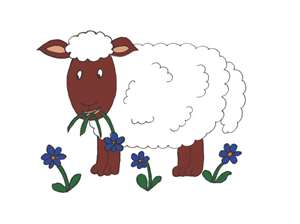|

| GABBY |
|
|
| BLACK BELLY BARBADOES EWE |




| 245 |
|
|
| DORPER/KATAHDIN CROSS EWE |



"HAIR" SHEEP
History
The wild ancestors of today's
domestic sheep breeds had long, coarse hair and a short, downy undercoat, which under domestication gradually became wool,
while the long hair disappeared. Wild sheep, such as the Mouflon, still do not have wooly coats.
No wool
Some
breeds of sheep remain true to their ancestors and do not have long, wooly coats that require shearing. This is because wool
is a disadvantage in many environments and not profitable to produce in many circumstances.
Found in the tropics
It
is estimated that approximately 10 percent of the world's sheep population is hair sheep, of which an estimated 90 percent
are found in Africa and 10 percent in Latin America and the Caribbean.
Gaining in popularity
Hair sheep
are increasing rapidly in popularity in the U.S. and other temperate climates because wool is not as profitable as it once
was and meat (lamb) is the primary source of income in the majority of sheep operations. Hair sheep are also valued for their
production efficiency and "easy-care" nature.
Hair vs. wool
Hair sheep are not a cross between sheep
and goats. They have the same number of chromosomes as wooled sheep. The primary difference between hair sheep and wooled
sheep is the ratio of hair to wool fibers. All sheep have both types of fibers. Hair sheep have more hair fibers and wool
sheep have more wool fibers. Wooled sheep need sheared. Hair sheep do not. Hair sheep also do not usually need their tails
docked. Most wooled sheep have their tails docked for reasons of health and sanitation.
Differences
Like
wooled breeds, there is considerable difference among hair sheep breeds, depending upon their origins. Some breeds and individuals
have short, slick hair coats, absent of wool, while others grow thicker coats that contain a mixture of hair and wool fibers
that shed naturally each year. Hair sheep tend to grow more wool fibers in cold climates, thus making them adaptable to different
climate extremes.
Shedding sheep
Some of the newer breeds of hair sheep are crosses between "pure" hair
sheep breeds and meat-type wooled breeds. They grow more wool than traditional hair sheep, but shed their coats annually and
do not require shearing. They may be more accurately identified as "shedding" sheep.
Other qualities
Besides
shedding their "fleeces," hair sheep have many other outstanding qualities. Those with tropical origins have a high level
of reproduction, are more resistant to internal parasites (worms) than conventional wooled sheep, and have a greater tolerence
for heat and humidity.
Better leather
From the standpoint of leather, the closer a sheepskin approaches
hair sheep, the tighter and firmer the fiber network, and, therefore, the better the skin for producing leather. This is the
case because the numerous fine wool fibers, as opposed to the lesser number of coarse fibers of the hair sheep, cause the
skin to be more open and loose in texture.
Lambs
Hair sheep lambs have excellent vigor. Their growth
rates vary according to their breed, genetics, and plane of nutrition. Many of the hair breeds fatten more like goats, depositing
fat around their internal organs before laying on external fat. As a result, they should probably not be full-fed in a feed
lot. As with goats, it's probably better to grow them more slowly on a lower energy, higher-roughage diet.
|

